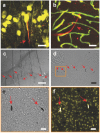Nanofabricated Ultraflexible Electrode Arrays for High-Density Intracortical Recording
- PMID: 29938162
- PMCID: PMC6010728
- DOI: 10.1002/advs.201700625
Nanofabricated Ultraflexible Electrode Arrays for High-Density Intracortical Recording
Abstract
Understanding brain functions at the circuit level requires time-resolved simultaneous measurement of a large number of densely distributed neurons, which remains a great challenge for current neural technologies. In particular, penetrating neural electrodes allow for recording from individual neurons at high temporal resolution, but often have larger dimensions than the biological matrix, which induces significant damage to brain tissues and therefore precludes the high implant density that is necessary for mapping large neuronal populations with full coverage. Here, it is demonstrated that nanofabricated ultraflexible electrode arrays with cross-sectional areas as small as sub-10 µm2 can overcome this physical limitation. In a mouse model, it is shown that these electrodes record action potentials with high signal-to-noise ratio; their dense arrays allow spatial oversampling; and their multiprobe implantation allows for interprobe spacing at 60 µm without eliciting chronic neuronal degeneration. These results present the possibility of minimizing tissue displacement by implanted ultraflexible electrodes for scalable, high-density electrophysiological recording that is capable of complete neuronal circuitry mapping over chronic time scales.
Keywords: electron‐beam lithography; flexible neural electrodes; high‐density intracortical recording; in vivo extracellular recording; nanofabrication.
Figures





Similar articles
-
Ultraflexible electrode arrays for months-long high-density electrophysiological mapping of thousands of neurons in rodents.Nat Biomed Eng. 2023 Apr;7(4):520-532. doi: 10.1038/s41551-022-00941-y. Epub 2022 Oct 3. Nat Biomed Eng. 2023. PMID: 36192597 Free PMC article.
-
Longitudinal neural and vascular recovery following ultraflexible neural electrode implantation in aged mice.Biomaterials. 2022 Dec;291:121905. doi: 10.1016/j.biomaterials.2022.121905. Epub 2022 Nov 14. Biomaterials. 2022. PMID: 36403326 Free PMC article.
-
Chronic co-implantation of ultraflexible neural electrodes and a cranial window.Neurophotonics. 2022 Jul;9(3):032204. doi: 10.1117/1.NPh.9.3.032204. Epub 2022 Jan 7. Neurophotonics. 2022. PMID: 35036472 Free PMC article.
-
Ultraflexible Neural Electrodes for Long-Lasting Intracortical Recording.iScience. 2020 Aug 21;23(8):101387. doi: 10.1016/j.isci.2020.101387. Epub 2020 Jul 20. iScience. 2020. PMID: 32745989 Free PMC article. Review.
-
Recording of brain activity across spatial scales.Curr Opin Neurobiol. 2015 Jun;32:68-77. doi: 10.1016/j.conb.2014.12.007. Epub 2014 Dec 24. Curr Opin Neurobiol. 2015. PMID: 25544724 Review.
Cited by
-
Intracranial recording in patients with aphasia using nanomaterial-based flexible electronics: promises and challenges.Beilstein J Nanotechnol. 2021 Apr 8;12:330-342. doi: 10.3762/bjnano.12.27. eCollection 2021. Beilstein J Nanotechnol. 2021. PMID: 33889479 Free PMC article. Review.
-
Opportunities and dilemmas of in vitro nano neural electrodes.RSC Adv. 2019 Dec 24;10(1):187-200. doi: 10.1039/c9ra08917a. eCollection 2019 Dec 20. RSC Adv. 2019. PMID: 35492533 Free PMC article. Review.
-
The neurotoxicity induced by engineered nanomaterials.Int J Nanomedicine. 2019 Jun 6;14:4167-4186. doi: 10.2147/IJN.S203352. eCollection 2019. Int J Nanomedicine. 2019. PMID: 31239675 Free PMC article. Review.
-
Chronic stability of a neuroprosthesis comprising multiple adjacent Utah arrays in monkeys.J Neural Eng. 2023 Jun 30;20(3):036039. doi: 10.1088/1741-2552/ace07e. J Neural Eng. 2023. PMID: 37386891 Free PMC article.
-
Ultraflexible electrode arrays for months-long high-density electrophysiological mapping of thousands of neurons in rodents.Nat Biomed Eng. 2023 Apr;7(4):520-532. doi: 10.1038/s41551-022-00941-y. Epub 2022 Oct 3. Nat Biomed Eng. 2023. PMID: 36192597 Free PMC article.
References
-
- Kotov N. A., Winter J. O., Clements I. P., Jan E., Timko B. P., Campidelli S., Pathak S., Mazzatenta A., Lieber C. M., Prato M., Bellamkonda R. V., Silva G. A., Kam N. W. S., Patolsky F., Ballerini L., Adv. Mater. 2009, 21, 3970.
-
- Nicolelis M. A., Ghazanfar A. A., Faggin B. M., Votaw S., Oliveira L. M., Neuron 1997, 18, 529. - PubMed
-
- Gray C. M., Maldonado P. E., Wilson M., McNaughton B., J. Neurosci. Methods 1995, 63, 43. - PubMed
-
- Wise K. D., Angell J. B., Starr A., IEEE Trans. Biomed. Eng. 1970, 17, 238. - PubMed
Grants and funding
LinkOut - more resources
Full Text Sources
Other Literature Sources
